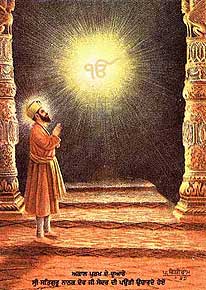
Guru Nanak at the abode of the Almighty Lord after presumed drowned in the Veiin River at Sultanpur. Coming out of the river after three days, the most memorable words were uttered by Him -'No Hindu - No Mussalman'.

Guru Nanak at the abode of the Almighty Lord after presumed drowned in the Veiin River at Sultanpur. Coming out of the river after three days, the most memorable words were uttered by Him -'No Hindu - No Mussalman'.
| Menu | |||||||||||||||||||||||||||||||||||||||||||||||||||||||||||||||||||
 | |||||||||||||||||||||||||||||||||||||||||||||||||||||||||||||||||||
| [Part 2] [Part 3] | |||||||||||||||||||||||||||||||||||||||||||||||||||||||||||||||||||
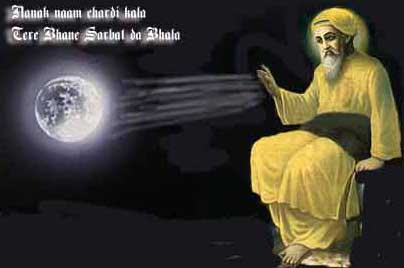 | |||||||||||||||||||||||||||||||||||||||||||||||||||||||||||||||||||
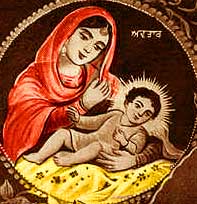 | |||||||||||||||||||||||||||||||||||||||||||||||||||||||||||||||||||
| Guru Nanak, the founder of Sikhism was born in (Katak Pooranmashi)- 30th November 1469 AD (some historians have mentioned April 15 as the date of birth, but my research agrees with the Katak Pooranmashi date of 30th Novbember - see my article in "Researches" section "Katak ke Visakh in Punjabi) at Nankana Sahib in Pakistan. His father Kalyan Chand, shortened by the biographers to Kalu, a Khatri by caste was the village Patwari (Accountant) who kept records. The name of Guru Nanak's mother was Mata Tripta. Guru Nanak was sent for instruction in Hindi to Pandit Gopal in 1475 AD for Sanskrit to Pandit Brij Lal in 1478 AD and for Persian to Maulvi Kutubdin in 1481 AD. But the Guru was looking for much wider meaning in education rather than mere literacy. As the Guru entered his eleventh year, he had attained the age when he must, according to prescribed usage, be given the janeu (sacred thread). As a boy, he used to take the cattle to pasture. But he was devoting his solitude to inward communion. His father wanted him to enter business but he preferred to spend the money on feeding the hungry sadhus (mendicants). | |||||||||||||||||||||||||||||||||||||||||||||||||||||||||||||||||||
| The Incarnation | |||||||||||||||||||||||||||||||||||||||||||||||||||||||||||||||||||
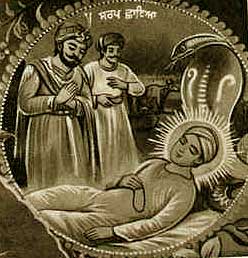 | |||||||||||||||||||||||||||||||||||||||||||||||||||||||||||||||||||
| Serpent protecting Nanak from sun | |||||||||||||||||||||||||||||||||||||||||||||||||||||||||||||||||||
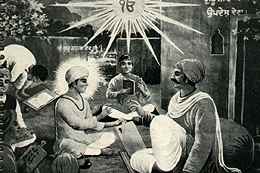 | |||||||||||||||||||||||||||||||||||||||||||||||||||||||||||||||||||
| In 1484 AD Guru Nanak was sent to his sister Nanaki at Sultanpur Lodhi where he took up a job as storekeeper of Daulat Khan Lodhi. During his stay at Sultanpur, he was married in 1487 AD and was blessed with two sons Sri Chand and Lakhami Das. Here he continued his spiritual vocation along with his work as a storekeeper | |||||||||||||||||||||||||||||||||||||||||||||||||||||||||||||||||||
| Nanak at school-preaching to Pandit | |||||||||||||||||||||||||||||||||||||||||||||||||||||||||||||||||||
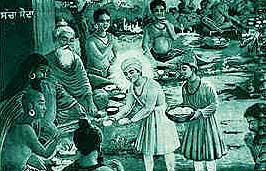 | |||||||||||||||||||||||||||||||||||||||||||||||||||||||||||||||||||
| Nanak was given money to do some business, but he spent it feeding some Sadhus | |||||||||||||||||||||||||||||||||||||||||||||||||||||||||||||||||||
| Once, while at Sultanpur, he did not return home after his morning ablutions in the Bein (rivulet) for three days. This was an interval of vivid mystical experience. On reappearance Guru Nanak uttered: "There is no Hindu, there is no Musalman." He was now ready to go forth into the wider world with the message he had to impart. Guru Nanak left Sultanpur in 1497 AD with Mardana on his first missionary travel covering Hardwar, Delhi, Varanasi, Guwahati, Jagannath Pun, Sri Lanka, Maharashtra, Gujarat, Ajmer, Mathura, Kurukshetra etc. He took three more travels taking him to all corners of India and the world. He visited Mecca (Saudi Arabia), Baluchistan, Afghanistan, Iran. Tibet and many places now in Pakistan. In his later years, Guru Nanak settled at Kartarpur (Pakistan) where he passed away in 1539 AD. He laid the foundation of Sikhism which was nurtured by nine other Gurus. 947 6f his hymns in 19 raags are included in the Adi Granth. Some of his important compositions are: Japji, Sidh Ghosht, Sodar, Sohila, Asa di Var, Barah Maha etc. | |||||||||||||||||||||||||||||||||||||||||||||||||||||||||||||||||||
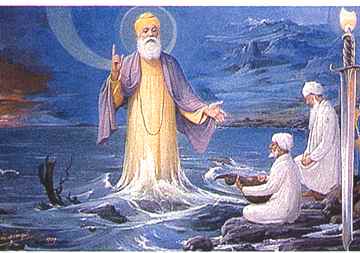 | |||||||||||||||||||||||||||||||||||||||||||||||||||||||||||||||||||
| Guru Nanak with Bala & Mardana | |||||||||||||||||||||||||||||||||||||||||||||||||||||||||||||||||||
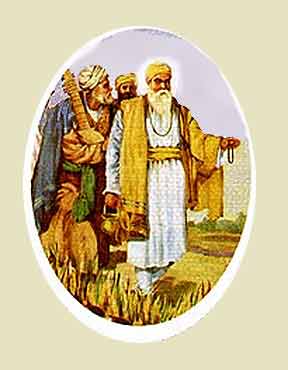 | |||||||||||||||||||||||||||||||||||||||||||||||||||||||||||||||||||
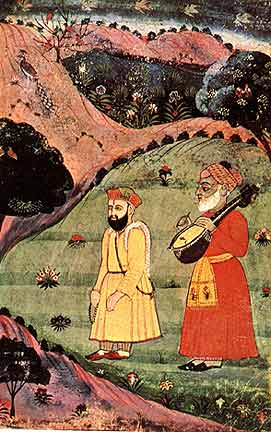 | |||||||||||||||||||||||||||||||||||||||||||||||||||||||||||||||||||
| Guru Nanak with Bala & Mardana on His Divine Mission | |||||||||||||||||||||||||||||||||||||||||||||||||||||||||||||||||||
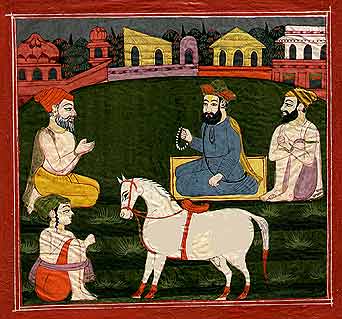 | 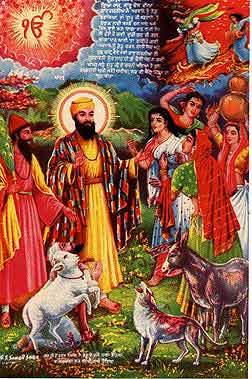 | ||||||||||||||||||||||||||||||||||||||||||||||||||||||||||||||||||
| Ajita Randhawa presents a mare to Guru Nanak - a scene from the Janamsakhi | |||||||||||||||||||||||||||||||||||||||||||||||||||||||||||||||||||
| Artist GS Sohan Singh showing Guru Nanak in the land of the witches, who have turned Mardana into a lamb. Guru Ji glued their pots on their heads and they begged for mercy and changed their wicked ways. | |||||||||||||||||||||||||||||||||||||||||||||||||||||||||||||||||||
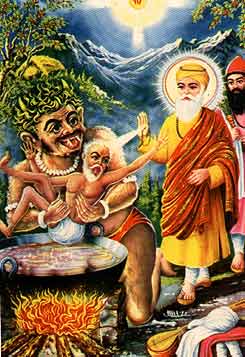 | |||||||||||||||||||||||||||||||||||||||||||||||||||||||||||||||||||
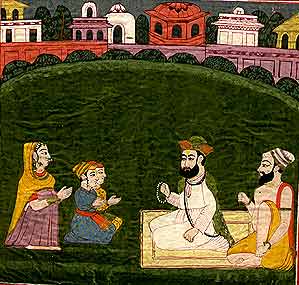 | |||||||||||||||||||||||||||||||||||||||||||||||||||||||||||||||||||
| On their divine journeys, Mardana was caught by a demon 'Kauda', who was in the process of frying the helpless Mardana, when Guru Nanak appeared and the oil in the couldren turned to ice. Kauda became GuruJi's follower. | |||||||||||||||||||||||||||||||||||||||||||||||||||||||||||||||||||
| Guru Nanak with his sons and wife Mata Choni also known as Mata Sulakhni. | |||||||||||||||||||||||||||||||||||||||||||||||||||||||||||||||||||
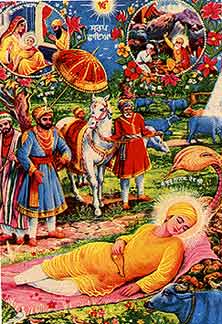 | |||||||||||||||||||||||||||||||||||||||||||||||||||||||||||||||||||
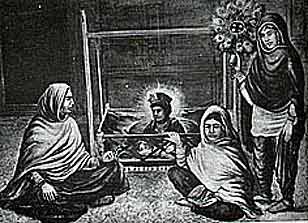 | |||||||||||||||||||||||||||||||||||||||||||||||||||||||||||||||||||
| Nanak in the cradle | |||||||||||||||||||||||||||||||||||||||||||||||||||||||||||||||||||
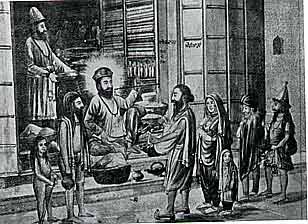 | |||||||||||||||||||||||||||||||||||||||||||||||||||||||||||||||||||
| Rai Bular, the Sultan, witnesses a cobra shielding Guru Nanak. Rai Bular was one of the first person to recognise the powers of Guru Nanak. | |||||||||||||||||||||||||||||||||||||||||||||||||||||||||||||||||||
| Guru Nanak at the Modikhana at Sultanpur, where presently the weights can be seen with which Guru Ji weighed the food. | |||||||||||||||||||||||||||||||||||||||||||||||||||||||||||||||||||
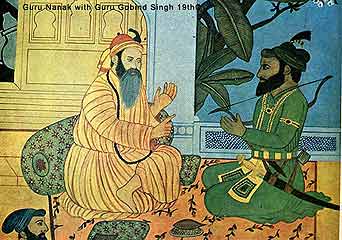 | |||||||||||||||||||||||||||||||||||||||||||||||||||||||||||||||||||
| A 19th century imaginary painting showing Guru Nanak with Guru Gobind Singh. | |||||||||||||||||||||||||||||||||||||||||||||||||||||||||||||||||||
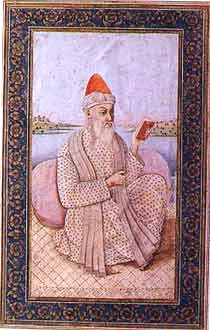 | |||||||||||||||||||||||||||||||||||||||||||||||||||||||||||||||||||
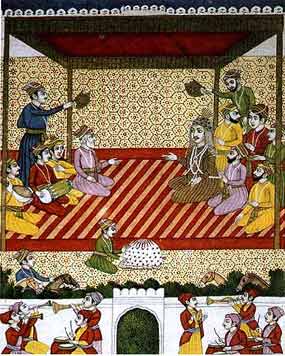 | |||||||||||||||||||||||||||||||||||||||||||||||||||||||||||||||||||
| A Muslim painters idea of Guru Nanak done in 1770 AD. (courtesy Kapani Collection) | |||||||||||||||||||||||||||||||||||||||||||||||||||||||||||||||||||
| Celebrations at Guru Nanak's wedding | |||||||||||||||||||||||||||||||||||||||||||||||||||||||||||||||||||
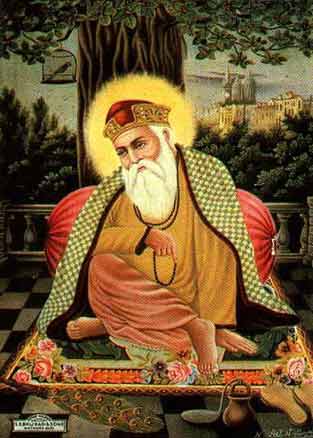 | |||||||||||||||||||||||||||||||||||||||||||||||||||||||||||||||||||
| NOTE: After some research it has been revealed that the above painting is not of Guru Nanak, but of "Khwaja Peer Mohammed Nakashband or Khwaja Bahauddin Naqshband" of the Silsila 'Naqshbandi'- a sect of Sufi Islam. The above information was relayed in the 'Punjab Times' by Dr. Chan of Coventry. | |||||||||||||||||||||||||||||||||||||||||||||||||||||||||||||||||||
| A sombre painting of Guru Nanak by Panna Lal GopiLal. | |||||||||||||||||||||||||||||||||||||||||||||||||||||||||||||||||||
| Next | |||||||||||||||||||||||||||||||||||||||||||||||||||||||||||||||||||